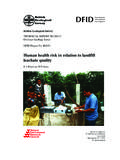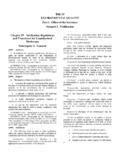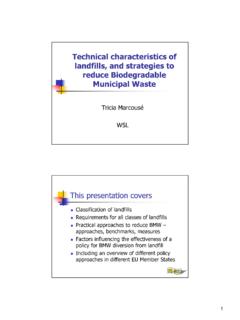Transcription of Management of radiation hazards from mining of …
1 Mineral sands mining in Western Australia by Greg Swensen Page 1 The Management of radiation hazards from the mining of mineralsands in Western Australia Life on earth has developed with an ever present background of radiation . It is not something new, inventedby the wit of man: radiation has always been there .11. IntroductionThis paper is concerned with the approach followed in Western Australian for dealing with the environmentalhazards of ionising radiation associated with the mining and processing of titaniferous minerals contained inmineral sands deposits. There is a growing public awareness of the risks posed by one of these minerals,monazite, which emits low levels of radiation as it contains thorium and uranium.
2 This concern has precipitatedincreased public scrutiny of practices adopted by the mineral sands industry to address the occupational and publichealth risks that arise from mining and of the industry s standards has come from a broad cross section of the public, includingenvironmental organisations, farmers and local community groups. The spotlight of public attention may havesomewhat tarnished the industry s well-established clean image derived from it s major end product, titaniumdioxide (TiO2), which is widely used in paints for its whiteness and in sunscreen products. This opposition issurprising as mineral sands mining has occurred continuously in Western Australia (WA) since the mid 1950swith little apparent opposition about environmental recent example of environmental concerns being associated with the industry is illustrated by the proposal toconstruct a rare earths oxide (REO)
3 Processing plant, which involves the processing of monazite at Pinjarra2 andthe transport of radioactive wastes for burial at a designated While opposition to the Pinjarra REO plantinvolves issues related to the transport, processing and disposal of low level radioactive waste, it has alsotriggered a wider debate about the benefits and costs of minerals sands mining . Examples of wider concern aboutenvironmental concerns include: pollution of local groundwater supplies and river systems through leakage from settling and evaporationponds;4 the transport of minerals by heavy haulage vehicles along local roads;5 dredging operations in fragile costal dunes;6 the clearing of forest to construct high voltage distribution systems to mine sites.
4 7 and the loss of remnant stands of native State s environmental impact assessment regime appears to discount this growing chorus of concerns aboutthe adequacy of the environmental safeguards applied to the mineral sands industry due to an overemphasis onprojected economic and social benefits by proponents in their environmental review and Management plans 1 Hall EJ. radiation and life . Nuclear Energy Agency Library ( ),June Guild F. Rare earths plant gets green light . Sunday Times 7 April 1996; Tan-Van Baren C, MacDonald J. radiation fears rejected . The West Australian 8 April 1995; Amalfi C.
5 Guarantee call on rare earths firm . The West Australian 7 August Capp G. Firm to push on with plant . The West Australian 16 July 1996; Amalfi C. Query over radiation tipdecision . The West Australian 23 July Lewis environmental Consultants. environmental review and Management program, heavy minerals mine Beenup .Perth, BHP-Utah Minerals International, 1990; BHP Titanium Minerals. Beenup titanium minerals project. Proposal to extend approved mining area, submitted in accordance with section 46 of the EP Act.
6 Perth, BHP TitaniumMinerals, BSD Consultants Pty Ltd, Mitchell McCotter & Associates, MA Ashbolt & Associates, Pregelj J. Mineral sands road study: Sue s Road to Capel, Public environmental Review. Perth , Main Roads Department, Dames and Moore. Westralian Sands Ltd. environmental review and Management program, Minninup sand mining proposal. Perth, Dames and Moore, Western Australia, environmental Protection Authority. Proposed 132 kV transmission line, Manjimup to Beenup mineral sands mine, State Energy Commission of Western Australia, report and recommendations.
7 EPA Bulletin 707 .Perth, environmental Protection Authority, Harris J. Forest monarchs - sandmining threatens a Tuart dynasty . 1989 17(6) Habitat Australia sands mining in Western Australia by Greg Swensen Page 2(ERMPs) and draft environmental impact statements (EIS). The dominance of economic imperatives in theState s environmental decision making process is underscored by a statement in a recent publication referring tothe minerals and energy sector as the bedrock of the State s economy as it accounts for around 25% of GrossState Product, some 73% of State exports and 65% of private investment .9It was recently observed this State s environmental Protection Act: is starkly different than other EIA legislation, in that it runs in tandem with resource developmentcontrols and is intended to aid the Minister for Environment in coming to a decision whether or not toallow a proposal to be implemented , rather than advise the public or a particular agency of the impactsof a proposed project.
8 10 Public participation in the environmental review process in relation to the processing monazite to extractconcentrated REOs is more problematic than other titaniferous minerals because:1. radiation hazard levels are determined by reference to Codes of Practice and standards set by national andinternational scientific and medical bodies;2. implementation of standards depends on complementary State and Commonwealth legislative arrangements;3. the enforcement of environmental and radiation standards is a State responsibility;4. the administrative arrangements established by the States are fragmented as they consist of provisionscontained in mining , radiation health and other legislative enactments; and5.
9 Monazite constitutes a minor proportion of total mineral sands structure of the paper is as follows. There is an overview of the environmental issues associated with theexploitation of mineral sands deposits, with particular reference to need for a framework to manage the risksposed by the release of low level ionising radiation once monazite has been separated at the dry processing stagefrom ilmenite, the major economic titaniferous mineral. This is followed by a short history of mineral sandsmining in WA. This history is concerned with the shift that has occurred from the 1970s to 1990s in miningand processing, from an export oriented operations in the Southern Swan Coastal Plain based on high gradedeposits, to mining of lower grade deposits in the Northern Swan Coastal Plain.
10 There will be consideration ofthe implications of this shift, with particular reference to the establishment of value added secondaryprocessing industries in close proximity to regional centres. Finally, the matrix of Commonwealth and Statestatutory provisions and guidelines concerned with the radiation hazards is examined to pinpoint some of theproblems posed through the mining , processing, storage and transport of environmental issues and the minerals sands industryThere are a number of reasons why it is important to examine the regulatory regime developed in this State todeal with the mining of titaniferous minerals. While all mineral sands deposits contain a small proportion ofmonazite, when this mineral is concentrated and separated through processing it emits a significant amount oflow level first reason is to ensure that former mineral sands mines are properly rehabilitated as they are progressivelydecommissioned after the depletion of ore bodies, or abandoned following low world commodity prices.







